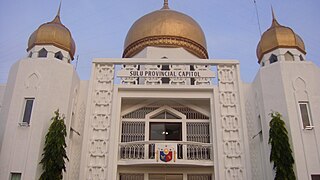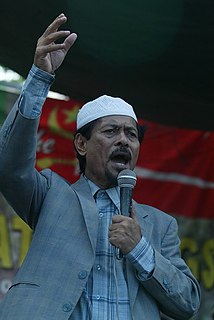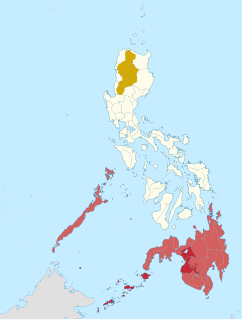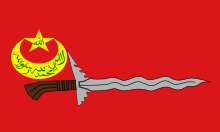
The Moro Islamic Liberation Front is a group based in Mindanao, Philippines, seeking an autonomous region of the Moro people from the central government. The group has a presence in the Bangsamoro region of Mindanao, the Sulu Archipelago, Palawan, Basilan, and other neighbouring islands. The armed wing of the group was the Bangsamoro Islamic Armed Forces (BIAF), although the name of its parent organization, the MILF, was often used to refer to the BIAF. In July, 2018, the Philippines government passed the Bangsamoro Organic Law, giving more autonomy to Muslims. In return, MILF announced that it would disarm its 30,000 fighters.

Sulu is a province of the Philippines in the Sulu Archipelago and part of the Bangsamoro Autonomous Region in Muslim Mindanao (BARMM).

The Autonomous Region in Muslim Mindanao was an autonomous region of the Philippines, located in the Mindanao island group of the Philippines, that consisted of five predominantly Muslim provinces: Basilan, Lanao del Sur, Maguindanao, Sulu, and Tawi-Tawi. It was the only region that had its own government. The region's de facto seat of government was Cotabato City, although this self-governing city was outside its jurisdiction.

The Moro people or Bangsamoro people are the 13 Muslim-majority ethnolinguistic Austronesian groups of Mindanao, Sulu, and Palawan, native to the region known as the Bangsamoro. As Muslim-majority ethnic groups, they form the largest non-Christian population in the Philippines, and comprise about 5% of the country's total population, or 5 million people.

The Moro National Liberation Front is a political organization in the Philippines that was founded in 1972. It started as a splinter group of the Muslim Independence Movement. The MNLF was the leading organization among Moro separatists for about two decades beginning from the 1970s.

Nur Misuari is a Moro Filipino revolutionary and politician, founder and leader of the Moro National Liberation Front.

The Moro conflict is an insurgency in the Mindanao region of the Philippines, which has involved multiple armed groups, and has been ongoing since March 1968. Peace deals have been signed between the Philippine government and two major armed groups - the Moro National Liberation Front (MNLF) and the Moro Islamic Liberation Front (MILF) - but other, smaller armed groups continue to exist.
Jamalul ibni Punjungan Kiram III was a former self-proclaimed Sultan of the Sulu Sultanate who claimed to be "the poorest sultan in the world". He was known as an unsuccessful candidate for senator in the Philippine general elections in 2007. In 2013, Kiram III sparked a controversy when he revived a dispute between the Philippines and Malaysia by leading an intrusion into the eastern part of Sabah. His daughter is Princess Jacel Kiram, a proponent of the Sabah claim of the Philippines in 2016.

The Moro National Liberation Front Executive Council of 15 is a faction of the Moro National Liberation Front (MNLF) in which the group of 15 leaders forged a unity agreement with the Moro Islamic Liberation Front (MILF). The agreement was signed in Kuala Lumpur and coincided with the Filipino President's visit. Muslimin Sema is the current chairman of the group. The government of the Philippines recognizes Sema along with Misuari as representatives of the MNLF despite the recognition of Nur Misuari as chairman by the Organisation of Islamic Cooperation, which the MNLF is an observer member to. Supposedly, Sema's group together with Habib Mudjahab Hashim's MNLF Islamic Command Council (ICC), somewhat agreed to reunite with the MNLF under Misuari.
Maradeka is an emerging pro-democracy Muslim political organization espousing non-violent political action in the Philippines amidst the backdrop of over four decades of armed Muslim insurgency mounted by Moro National Liberation Front (MNLF) and Moro Islamic Liberation Front (MILF) in their Moro Quest for self-rule after people dissenting Philippine government treatment of Muslim minority as second class citizens and suffering years of social, economic, and political inequities called Mindanao problem
In the late 1960s, an independence movement was founded in Mindanao, the Philippines to separate the Muslim majority-Moro areas from the rest of the Philippines.

Bangsamoro, officially the Bangsamoro Autonomous Region in Muslim Mindanao, is an autonomous region located in the southern Philippines.

The Bangsamoro Republik, officially the United Federated States of Bangsamoro Republik (UFSBR), was a short-lived, self-proclaimed, unrecognized breakaway state in the Philippines. Nur Misuari, chairman of the Moro National Liberation Front, issued the Proclamation of Bangsamoro Independence on July 27, 2013 in Talipao, Sulu and declared the capital of Bangsamoro to be Davao City.

The Zamboanga City crisis or Zamboanga Siege was an armed conflict in Zamboanga City, Philippines between the government forces of the Philippines and Moro rebels from the Moro National Liberation Front (MNLF) that began on September 9, 2013 and ended twenty days later on September 28. The conflict began when MNLF rebels, under the command of Nur Misuari, attempted to occupy several coastal communities in Zamboanga City in protest of the Philippine government's failure to implement the 1996 final peace agreement with the MNLF.

The 1976 Tripoli Agreement was signed on December 23, 1976 in Tripoli, Libya by Carmelo Z. Barbero, representing the Government of the Philippines and Nur Misuari of the Moro National Liberation Front. The agreement defined autonomous administrative divisions for Muslims in the southern Philippines, the establishment of an autonomous government, judicial system for Sharia law and special security forces, and the observance of a ceasefire. The autonomous region was to have its own economic system, including an Islamic bank.

The Jeddah Accord was signed on January 3–4, 1987 in Jeddah, Saudi Arabia by Aquilino Pimentel Jr., representing the Government of the Philippines and Nur Misuari of the Moro National Liberation Front. The two panels agreed upon the continued discussion of the proposal of the grant of full autonomy to Mindanao, Basilan, Sulu, Tawi-Tawi and Palawan subject to democratic processes.
The 1996 Final Peace Agreement, also called the Jakarta Accord was signed on September 2, 1996 in Manila, Philippines by Manuel Yan, representing the Government of the Philippines and Nur Misuari of the Moro National Liberation Front. The culmination of four years of peace talks, the agreement established mechanisms designed to bring about the full implementation of the 1976 Tripoli Agreement.

The 2001 rebellion of the Moro National Liberation Front Misuari faction against the Philippine government during the presidency of Gloria Macapagal Arroyo was led by Nur Misuari, the founder of the Moro National Liberation Front (MNLF). It began on November 19, 2001 when members of a faction of the MNLF loyal to Misuari attacked a Philippine Army headquarters in Jolo, Sulu in the Philippines. The attack was meant to disrupt the Autonomous Region in Muslim Mindanao elections scheduled for November 26 of that year, which eventually replaced Misuari as governor.
Abdul Raji Sahrin, also known as Hassan Jawali, was a Moro revolutionary and politician. He was a member of the Moro National Liberation Front (MNLF) and the Interim Bangsamoro Parliament. He was also the Deputy Chief Minister of Bangsamoro for the Islands.

Separatism in the Philippines refers to bids for secession or greater autonomy for certain areas in the Philippines. The scope of the article includes such efforts since the Philippine Revolution both currently and historical.












